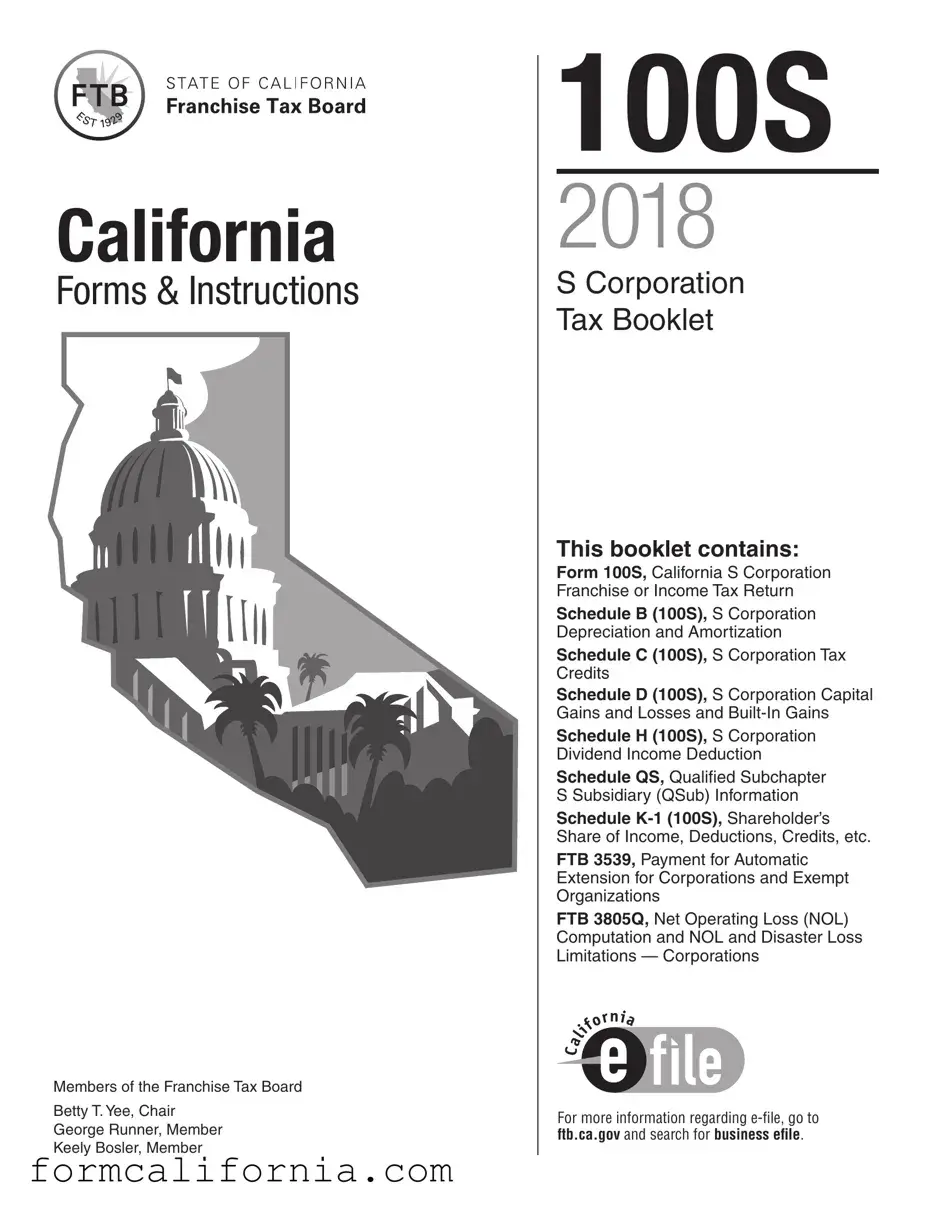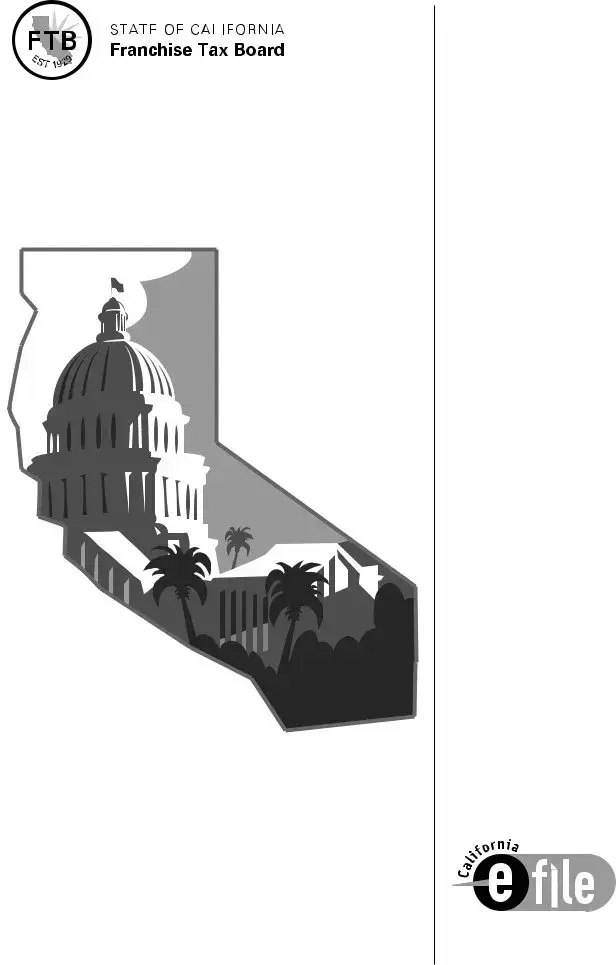activities before any NOL and special deductions on Form 100S, Side 1, line 1.
c.Enter the state adjustments (including any adjustments necessary to report items not included in ordinary trade or business income or loss) on Form 100S, Side 1 and Side 2, line 2 through
line 13, to arrive at net income (loss) after state adjustments, Form 100S, Side 2, line 14.
2.Schedule F – California Computation Method
If the S corporation has no federal filing requirement, or if the S corporation maintains separate records for state purposes, complete Form 100S, Side 4, Schedule F, to determine state ordinary income. If ordinary income is computed under California laws, generally no state adjustments are necessary. Transfer the amount from Schedule F, line 22, to Form 100S, Side 1, line 1. Complete Form 100S, Side 1 and Side 2, line 2 through line 13, only if applicable.
See Specific Line Instructions for more information.
Regardless of the net income computation method used, the S corporation must attach any form, schedule, or supporting document referred to on the return, schedules, or forms filed with the FTB.
Substitution of Federal Schedules
S corporations may not substitute federal schedules for California schedules.
J Built-In Gains
When a C corporation elects to be an
S corporation, certain items of gain or loss recognized in S corporation years are subject to the C corporation 8.84% tax rate instead of the S corporation 1.5% tax rate (financial S corporations add 2%).
Built-In Gains Under Current IRC
Section 1374
For those S corporations that made the initial federal S election after December 31, 1986, certain income items reported by the
S corporation are taxed at 8.84% (or the financial C corporation tax rate). This provision applies for a period of ten years following the C corporation’s election to become an S corporation. The amount of built-in gain that is taxed at 8.84% (or the financial C corporation tax rate) is the excess of recognized built-in gains over recognized built-in losses, limited by taxable income as determined under IRC Section 1374(d)(2)(A). The following items are treated as built-in gains subject to this tax:
yAccounts receivable of cash basis taxpayers from C corporation years.
yLong-term contract deferred income from C corporation years.
yDeferred income from installment sales made in C corporation years.
yRecapture of depreciation from C corporation years.
yIncome from unreplaced last-in, first-out (LIFO) inventory from C corporation years.
yAny other income item that is attributable to C corporation years.
These are just a few of the examples. This list is not intended to be all inclusive.
For Apportioning Corporations Only:
All recognized built-in gains and all recognized built-in losses are apportioned and allocated to California according to the current year Schedule R.
K Estimated Tax
Every S corporation must pay estimated tax using Form 100-ES, Corporation Estimated Tax.
Corporations are required to pay the following percentages of the estimated tax liability during the taxable year:
y30% for the first required installment
y40% for the second required installment
yNo estimated tax payment is required for the third installment
y30% for the fourth required installment
For exceptions and prior year’s information, get Form 100-ES.
Estimated tax is generally due and payable in four installments as follows:
yThe 1st payment is due on the 15th day of the 4th month of the taxable year. This payment may not be less than the minimum franchise tax plus QSub annual tax, if applicable.
yThe 2nd, 3rd, and 4th installments are due and payable on the 15th day of the 6th, 9th, and 12th months, respectively, of the taxable year.
If no amount is due, do not mail Form 100-ES.
California law conforms to the federal expanded annualization periods for the computation of estimate payments. The applicable percentage for estimate basis is 100%.
Get the instructions for Form 100-ES for more information.
If the corporation must pay its tax liability electronically, all estimate payments due must be remitted by EFT, EFW, Web Pay, or credit card to avoid the EFT penalty. See General Information G, Electronic Payments, for more information.
L New/Commencing
S Corporations
An S corporation is required to pay measured tax instead of minimum tax for the first taxable year if the corporation incorporated or registered through the California SOS. For more information, see General Information B, Tax Rate and Minimum Franchise Tax, or get FTB Pub. 1060.
M Penalties
Failure to File a Timely Return
Any corporation that fails to file Form 100S on or before the extended due date is assessed a delinquent filing penalty. The delinquent filing penalty is computed at 5% of the tax due, after allowing for timely payments, for every month that the return is late, up to a maximum of 25%. If the S corporation does not file its return by the extended due date, the automatic extension will not apply and the late filing penalty will be assessed from the original due date of the return. See R&TC Sections 19131 and 23772 for more information.
Unless failure is due to reasonable cause, a penalty will be assessed against the
S corporation if it is required to file an
S corporation return and one of the following occurs:
yThe S corporation fails to file the tax return by the due date, including extensions.
yThe S corporation files a return that fails to show all of the information required pursuant to R&TC Section 18601.
The amount of the penalty for each month, or part of a month (for a maximum of 12 months) that the failure continues, is $18 multiplied
by the total number of shareholders in the S corporation during any part of the taxable year for which the return is due. See R&TC Section 19172.5 for more information.
Failure to Pay Total Tax by the Due Date
Any S corporation that fails to pay the total tax shown on Form 100S by the original due date is assessed a penalty. The penalty is 5% of the unpaid tax, plus 0.5% for each month, or part of the month (not to exceed 40 months) the tax remains unpaid. This penalty may not exceed 25% of the unpaid tax. See R&TC Section 19132 for more information.
The FTB may waive the late payment penalty based on reasonable cause. Reasonable cause is presumed when 90% of the tax shown
on the return, but not less than minimum franchise tax if applicable, is paid by the original due date of the return. However, the imposition of interest is mandatory.
Corporations that meet the requirements for filing form FTB 3593 may extend the time for payment of taxes and are not subject to late payment penalties. For more information, get form FTB 3593.
If an S corporation is subject to both the penalty for failure to file a timely return and the penalty for failure to pay the total tax by the due date, a combination of the two penalties may be assessed, but the total will not exceed 25% of the unpaid tax.
Underpayment of Estimated Tax
Any S corporation that fails to pay, pays late, or underpays an installment of estimated tax is assessed a penalty. The penalty is a percentage of the underpayment of estimated tax for the period from the date the installment was due until the date it is paid, or until the original due










